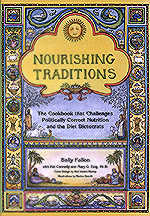Traditional Diets
by Sally Fallon
Author of Nourishing
Traditions
Part three of a three part article ( Part1 Part2
)
What researchers often overlook is the fact that seed foods—grains,
legumes and nuts—are prepared with great care in traditional
societies, by sprouting, roasting, soaking, fermenting and
sour leavening.22 These processes neutralize substances
in whole grains and other seed foods that block mineral
absorption, inhibit protein digestion and irritate the lining
of the digestive tract. Such processes also increase nutrient
content and render seed foods more digestible.
For example, in India, rice and lentils are fermented for
at least two days before they are prepared as idli and dosas;
in Africa the natives soak coarsely ground corn overnight
before adding it to soups and stews and they ferment corn
or millet for several days to produce a sour porridge called
ogi; a similar dish made from oats was traditional among
the Welsh.
 In
some Oriental and Latin American countries rice receives
a long fermentation before it is prepared; Ethiopians make
their distinctive injera bread by fermenting a grain called
teff for several days; Mexican corn bread cakes, called
pozol, are fermented for several days and for as long as
two weeks in banana leaves; Cherokee bread was similar,
but wrapped in corn husks.
In
some Oriental and Latin American countries rice receives
a long fermentation before it is prepared; Ethiopians make
their distinctive injera bread by fermenting a grain called
teff for several days; Mexican corn bread cakes, called
pozol, are fermented for several days and for as long as
two weeks in banana leaves; Cherokee bread was similar,
but wrapped in corn husks.
Before the introduction of commercial brewers yeast, Europeans
made slow-rise breads from fermented starters; in America
the pioneers were famous for their sourdough breads, pancakes
and biscuits; and throughout Europe grains were soaked overnight,
and for as long as several days, in water or sour milk before
they were cooked and served as porridge or gruel. Grains
carefully prepared in this manner confer far more nutritional
value than modern quick rise breads, granolas, rice bran
concoctions, extruded breakfast cereals and, of course,
denuded white flour products.
Weston Price's studies convinced him that the best diet
was one that combined nutrient-dense whole grains with animal
products, particularly fish. The healthiest African tribe
he studied was the Dinkas, a Sudanese tribe on the western
bank of the Nile. They were not as tall as the cattle-herding
Neurs groups but they were physically better proportioned
and had greater strength. Their diet consisted mainly of
fish and cereal grains. This is one of the most important
lessons of Price's research—that a mixed diet of whole
foods, one that avoids the extremes of the carnivorous Masai
and the largely vegetarian Bantu, ensures optimum physical
development.
Purists argue that, as with grains, man should not eat
dairy products because the keeping of herds dates back only
a few thousand years, a mere drop of time in the evolutionary
bucket. But there are many healthy milk-drinking populations
including disease-free traditional Europeans, Americans
up to the first World War, Greeks and other inhabitants
of the Mediterranean, Africans, Tibetans, the long-lived
inhabitants of Soviet Georgia and the hearty Mongols of
Northern China.
 Even
today, the use of relatively processed milk products is
associated with longevity in countries like Austria and
Switzerland.23 Modern milk is denatured through pasteurization
and homogenization; stripped of its valuable fat content;
filled with antibiotics and pesticides; laced with additives
and synthetic vitamins; and comes from cows bred to produce
huge amounts of milk and fed everything under the sun except
what cows are supposed to eat—green grass.24 There
is evidence to link such milk with the whole gamut of modern
ailments including heart disease, cancer, diabetes, breast
cancer, osteoporosis, autism and allergies.
Even
today, the use of relatively processed milk products is
associated with longevity in countries like Austria and
Switzerland.23 Modern milk is denatured through pasteurization
and homogenization; stripped of its valuable fat content;
filled with antibiotics and pesticides; laced with additives
and synthetic vitamins; and comes from cows bred to produce
huge amounts of milk and fed everything under the sun except
what cows are supposed to eat—green grass.24 There
is evidence to link such milk with the whole gamut of modern
ailments including heart disease, cancer, diabetes, breast
cancer, osteoporosis, autism and allergies.
Other practices common to traditional groups throughout
the world include the use of animal bones, usually made
into broth that is added to soups, stews and sauces; the
preservation of vegetables, fruits, grains and even meats
through the practice of lacto-fermentation to make condiments,
meat products and beverages; and the use of salt. In areas
where salt is not available, sodium-rich grasses and other
plants are burnt and added to foods.
Familiar lacto-fermented foods include old-fashioned sauer
kraut and yoghurt. Almost any food can be preserved by this
method, which encourages the proliferation of beneficial
bacteria. The lactic acid they produce is an excellent,
natural preservative prevents spoilage in plant foods as
pickles and chutneys, meats as sausage and haggis, milk
as a variety of soured products and grains as chewy breads
and thick sour porridges. Lacto-fermented beverages are
ubiquitous in traditional cultures—from kaffir beer
in Africa to kvass and kombucha in Slavic regions. Lacto-fermented
foods are artisinal products—instead of mass produced
items preserved with vinegar and sugar—which taste
delicious and confer many health benefits. They add valuable
enzymes to the diet, and enhance digestibility and assimilation
of everything we eat.
Gelatin-rich broth also enhances digestion and provides
the gamut of macro-minerals in easily assimilated form.
Broth-based soups are snack foods in Asian countries, usually
prepared in mom-and-pop shops; and they form the basis of
both peasant and gourmet cuisines throughout Europe. But
in most western countries, the stock pot has given way to
convenience foods whose meat-like favor derives from flavor
enhancers—MSG and other neurotoxic additives.
 The
first happy lesson gleaned from a study of traditional diets
is that healthy food can and should taste good; that we
can put butter on our porridge and cook in lard, that it's
OK to consume whole milk, fatty meats, liver and onions,
lox and cream cheese, shrimp and lobster, even insects,
if you like them; that heavenly sauces made from bone broth
and cream confer more benefits than pills and powders and
ersatz low-fat concoctions, the stepchildren of technology,
pawned off as health foods.
The
first happy lesson gleaned from a study of traditional diets
is that healthy food can and should taste good; that we
can put butter on our porridge and cook in lard, that it's
OK to consume whole milk, fatty meats, liver and onions,
lox and cream cheese, shrimp and lobster, even insects,
if you like them; that heavenly sauces made from bone broth
and cream confer more benefits than pills and powders and
ersatz low-fat concoctions, the stepchildren of technology,
pawned off as health foods.
Wisely used, technology can take the drudgery out of cooking,
and help us bring properly grown and prepared foods to the
marketplace. Wrongly used, technology produces breads that
are soft and sweet rather than sour and chewy; coca-cola
rather than cottage-industry lacto-fermented soft drinks;
bouillon cubes rather than homemade broth; sugar-embalmed
ketchup with infinite shelf life rather than enzyme-rich
condiments and pickles preserved to last a few months in
a way that adds nutrients instead of taking them away.
The second lesson is that healthy eating is good for the
ecology. The building blocks of a healthy diet are pesticide-free
foods raised on mineral-rich soil, and healthy animals that
live free to manure the paddocks of thousands of farms,
rather than suffer in factories, confined to misery and
disease. The road to health starts with a willingness to
pay a good price for such food, thus rewarding the farmer
who preserves the land through wise farming practices, rather
than the agribusiness that mines the soil for quick profits.
And, finally, a return to traditional foods is a way of
taking power away from the multinationals and giving it
back to the artisan. The kind of food processing that makes
food more nutritious is the same kind of food processing
that the farmer or the farming community can do in situ—sour
milk and grain products, aged cheeses, pickles, sausages,
broth and beverages. All the boxed, bottled and frozen products
in modern supermarkets—the cheerios, crackers, cookies,
egg-beaters, margarines, diet sodas and TV dinners—have
made fortunes for a few and impoverished the rest of us.
The way we eat determines not only how healthy we will be,
but what kind of economy we have—the kind where a
few people make millions and millions of dollars or the
kind where millions of people make a decent living.
Technology propels us headlong into the future, but there
will be no future unless that technology is tamed to the
service of wise ancestral foodways.
end notes
click here
© 1999 Sally Fallon. All Rights Reserved.
First published in The Ecologist, Vol 29, No 1, January/February
1999.

The Cookbook that Challenges Politically
Correct Nutrition and the Diet Dictocrats.
This well-researched, thought-provoking
guide to traditional foods contains a startling message:
Animal fats and cholesterol are not villains but vital factors
in the diet, necessary for normal growth, proper funciton
of the brain and nervous system, protection from disease
and optimum energy levels. Sally Fallon dispels the myths
of the current low-fat fad in this practical, entertaining
guide to a can-do diet that is both nutritious and delicious.
Order
Sally Fallon's book at our bookshop
Or order via mail: Ash Tree Publishing PO Box 64
Woodstock, NY 12498
include a check or money order for $29.95 (Nourishing Traditions
retails for $25.00 plus $4.95 shipping






